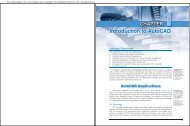Chapter 1 - Goodheart-Willcox
Chapter 1 - Goodheart-Willcox
Chapter 1 - Goodheart-Willcox
Create successful ePaper yourself
Turn your PDF publications into a flip-book with our unique Google optimized e-Paper software.
24 <strong>Chapter</strong> 1 A Close-Up View of You<br />
section<br />
1:1<br />
Your Life Path<br />
Sharpen Your Reading<br />
Outline concepts as you read, listing key points<br />
under the following headings: Definition, Qualities of<br />
Your Life Path, Changes Along Your Life Path, and<br />
Preparing for Change.<br />
Boost Your Vocabulary<br />
Pick an object that you think describes you and<br />
explain how it relates to your identity. Include your<br />
strengths and areas you need to improve.<br />
Birth<br />
Childhood<br />
years<br />
Elementary<br />
years<br />
Teen<br />
years<br />
Know Key Terms<br />
life span<br />
gene<br />
developmental task<br />
self-identity<br />
Life can be thought of as a path. Your birth<br />
marks the beginning of your path in this world.<br />
Death marks the end of this path. Your path from<br />
birth to death is called your life span, 1-1.<br />
No one knows just how long their life span<br />
will be. The average life span today for men is<br />
72 years; for women, it is 79 years. These are<br />
averages expected for people who are teens<br />
today.<br />
You are unique. No one else is exactly like<br />
you. You started your life path with your own set<br />
of genes, received from your parents. A gene is<br />
the basic unit of heredity. Your unique pattern of<br />
genes is defined as your DNA, which has about<br />
three billion base pairs of genetic material. Your<br />
DNA is so distinctive that it can be used as a<br />
method of identification.<br />
Young adult<br />
years<br />
Adult<br />
years<br />
Older adult<br />
years<br />
1-1 Although your life path is unique, you will pass through the same growth stages as all people do.<br />
Death<br />
As a unique person, you have your own daily<br />
life experiences. You also share many experiences<br />
with others. Your life path crosses their life paths<br />
every day. You depend on other people and are<br />
influenced by them. In turn, they are influenced<br />
by you.<br />
Some people have a direct influence on your<br />
life path. They may give you food, clothes, and<br />
shelter so you feel warm and secure. They may<br />
give you a hug or praise so you feel loved. Such<br />
actions and words affect you in a direct way.<br />
People’s actions can also influence you<br />
indirectly. For instance, you may not be invited<br />
to a friend’s party. As a result, you feel hurt<br />
although no one speaks directly to you about it.<br />
You can also directly or indirectly impact others.<br />
Who you are, what you say, and what you do or<br />
Section 1:1 Your Life Path 25<br />
do not do are all important. There is no need to pretend—you can let others<br />
know the real you. Accepting yourself can help<br />
you develop relationships with others.<br />
Use What You Learn<br />
Think of the last item you purchased. Who<br />
was indirectly affected by your purchase?<br />
Who was directly affected?<br />
Changes over Your Life<br />
Span<br />
As a teen, you have major developmental<br />
tasks to achieve. A developmental task is<br />
a skill that society expects of individuals at<br />
various stages of life. Accomplishing these tasks<br />
successfully helps you become an adult, 1-2.<br />
Understanding and<br />
Accepting Yourself<br />
One developmental task of the teen years is<br />
to figure out who you are. Asking the question<br />
“Who am I?” helps you clarify your self-identity.<br />
This is a sense of individuality. Exploring the<br />
answers to this question will help you feel that<br />
you have worth and value.<br />
Identifying who you are can help you accept<br />
yourself. When you accept yourself, it is easier<br />
to believe that others will accept you as you are.<br />
•<br />
•<br />
•<br />
•<br />
•<br />
Developmental Tasks<br />
Understand and accept who you are.<br />
Make healthful choices that help you<br />
grow to maturity.<br />
Develop mature relationships with<br />
others.<br />
Prepare for an occupation.<br />
Prepare for marriage and family living.<br />
1-2 Teens have major developmental tasks to accomplish<br />
as they enter adulthood.<br />
Growing to Maturity<br />
Knowing your self-identity will also allow<br />
you to make choices that will help you grow to<br />
maturity. When you know and accept yourself as<br />
you are, you recognize your good and bad points.<br />
You can use your strengths to make choices that<br />
help you reach personal goals. You can also make<br />
choices to improve the areas in which you are<br />
weak.<br />
Developing Mature<br />
Relationships<br />
Adolescence is a time for growth toward<br />
maturity in many relationships. During the<br />
teen years, your position in the family changes.<br />
Your relationship with your parents becomes<br />
one of decreasing dependence and increasing<br />
independence. You gain a new respect for your<br />
parents as you mature.<br />
Friendships also change and mature. True<br />
friendships, which involve care and concern for<br />
a friend’s well-being, become important. This is<br />
true of friendships with both sexes.<br />
In addition, relationships develop with<br />
people at work. As you get your first job and gain<br />
work experience, you learn to become a member<br />
of a work team. Learning to work well in a group<br />
makes it possible to succeed at work.

















